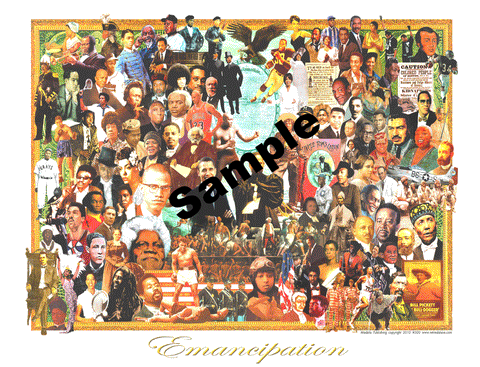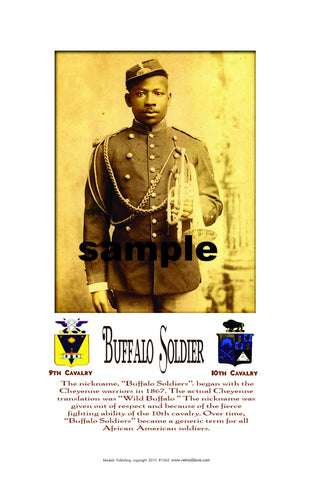Tuskegee Airmen #1460
$ 8.00
Caption from poster__
Tuskegee Airmen
The Tuskegee Airmen were dedicated, determined young men who
enlisted to become America's first black military airmen, at a time
when there were many people who thought that black men lacked
intelligence, skill, courage and patriotism. They came from every
section of the country, with large numbers coming from New York
City, Washington, Los Angeles, Chicago, Philadelphia and ,Detroit.
Each one possessed a strong personal desire to serve the United
States of America at the best of his ability. Those who possessedthe physical and mental qualifications were accepted as aviation
cadets to be trained initially as engine pilots, navigators or bom-
bardiers. Most were college graduates or undergraduates. Others
demonstrated their academic qualifications through comprehensive
entrance examinations. No standards were lowered for the pilots
or any of the others who trained in operations, meteorology, intelli-
gence, engineering, medicine or any of the other officer fields.
Enlisted members were trained to be aircraft and engine mec-
hanics, armament specialists, radio repairmen, parachute riggers,
control tower operators, policemen, administrative clerks and all
of the other skills necessary to fully function as an Army Air Corps
flying squadron or ground support unit. The black airmen who
became single engine or multi-engine pilots were trained at
Tuskegee Army Air Field (TAAF) in Tuskegee Ala., The first
aviation cadet class began in July 1941, and completed train-
ing nine months later in March 1942. Thirteen started in the
first class. Five successfully completed the training, one of
them being Captain Benjamin O. Davis, Jr., a West Point
Academy graduate. The other four were second lieuten-
ants, and all five received Army Air Corps silver pilot wings.
From 1941, through 1946, nine hundred and ninety-four pilots
graduated at TAAF, receiving commissions and pilot wings.
Black navigators, bombardiers and gunnery crews were
trained at selected military bases elsewhere in the United
States. Mechanics were trained at Chanute Air Base in
Rantoul, Illinois until facilities were in place in 1942, at
TAAF. Our hundred and fifty of the pilots who were
trained at TAAF served overseas in either the 99th
Pursuit Squadron (late the 99th Fighter Squadron) or the
332nd Fighter Group. The 99th Fighter Squad trained in
and flew P-40 War hawk aircraft in combat in North Africa,
Sicily and Italy from April 1943, until July 1944, when they
were transferred to the 332nd Fighter Group in the 15th
Air Force. The outstanding record of black airmen in
World War II was accomplished by men whose names
will forever live in hallowed memory. Each one accepted
the challenge, proudly displayed his skill and determination
while suppressing internal rage from humiliation and indig-
nation caused by frequent experiences of racism and
bigotry, at home and overseas. These airmen fought two
wars one against a military force overseas and the other
against racism at home and abroad. After the war in
Europe ended in 1945, black airmen returned to the
United States and faced continued racism and bigotry
despite their outstanding war record. Tuskegee Army
Air Field continued to train new airmen until 1946,
with women entering the program in several support
fields. Large numbers of black airmen elected to
remain in the service but because of segregation
their assignments were limited to the 332nd Fighter
Group or the 477th Composite Group, and later to the
332nd Fighter Wing at Lockbourne Air Base, Ohio.
Opportunities for advancement and promotion were
very limited and this affected morale. Nevertheless,
black airmen continued to perform superbly. In 1949,
pilots from the 332nd Fighter Group took first place
in the Air Force National Fighter Gunnery Meet at
Las Vegas Air Force Base, Nevada.




